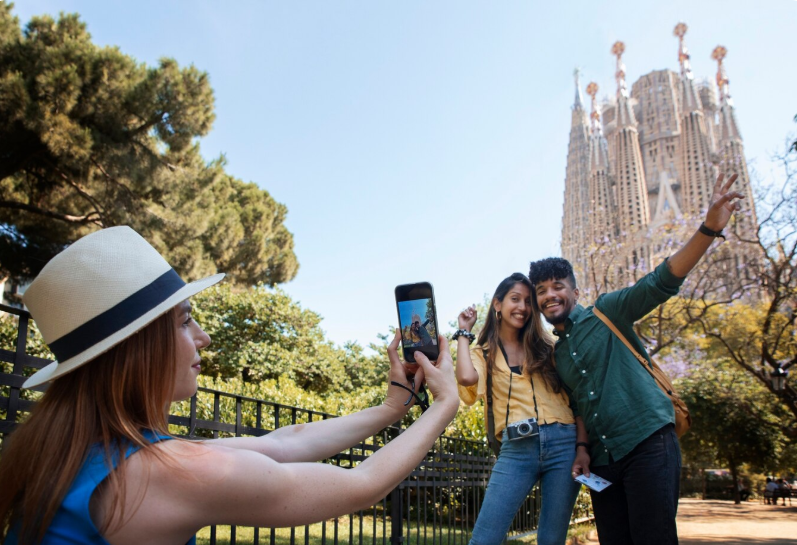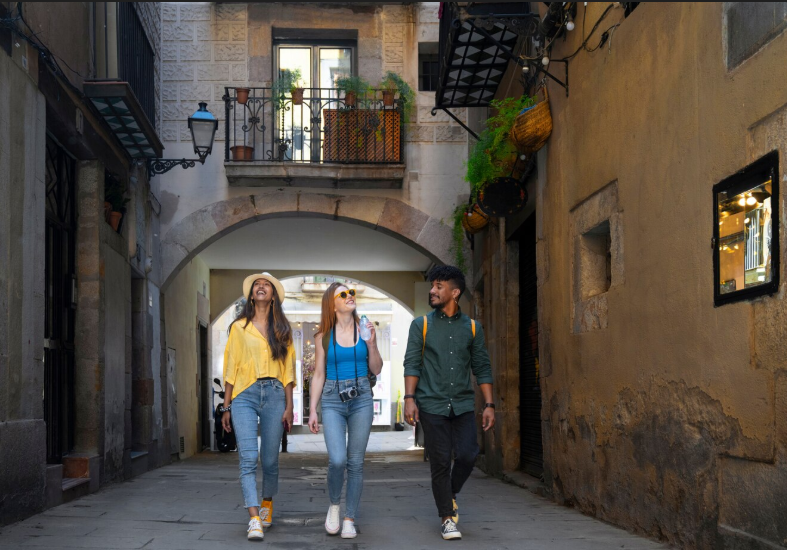
by Dulce Navarro | Jun 25, 2025 | Countries, Culture, Languages, Travel, Worldwide
Language and Identity: How Multilingualism Shapes Worldviews
Language is more than just a communication tool — it is a core component of our identity, a filter through which we understand the world, and a bridge between cultures. In today’s globalized world, multilingualism is not just an asset but a transformative force that shapes how individuals see themselves and others. Whether for personal enrichment, professional advancement, or cultural integration, speaking multiple languages expands the mind and opens doors.
The Cognitive Power of Multilingualism
Research consistently shows that multilingual individuals enjoy enhanced cognitive abilities. From improved memory and problem-solving to greater creativity and multitasking skills, speaking more than one language rewires the brain in powerful ways. Multilingual people are often more adept at switching between tasks and filtering out irrelevant information, making them highly adaptive in fast-paced environments.
Language as a Lens on Culture
Each language carries its own set of values, metaphors, and ways of framing reality. For example, the Japanese concept of “wabi-sabi” — appreciating the beauty in imperfection — is difficult to translate but reflects a distinct worldview embedded in the language. When someone becomes fluent in another language, they don’t just learn new words; they adopt new ways of seeing the world.
Multilingualism and Personal Identity
Multilingual individuals often describe having slightly different personalities in each language they speak. This phenomenon, known as “language-based identity,” illustrates how language influences not only our outward expression but our internal sense of self. A bilingual person might be more assertive when speaking English but more reserved in their native tongue, depending on cultural expectations embedded in the language.
Breaking Down Barriers
Multilingualism breaks down social and professional barriers. In multicultural societies or international business environments, the ability to switch languages fosters trust, collaboration, and mutual respect. It allows for more meaningful interactions and reduces the chance of miscommunication — especially important in diplomatic, legal, or healthcare contexts where nuance matters.
Multilingualism in the Workplace
In business, multilingualism is a clear competitive advantage. Companies with multilingual employees can more effectively navigate foreign markets, communicate with international clients, and localize products and services. It demonstrates cultural sensitivity and global thinking, qualities increasingly valued by employers worldwide.
Preserving Linguistic Diversity
While globalization often leads to language homogenization, multilingualism plays a vital role in preserving cultural diversity. Each language is a repository of history, knowledge, and collective memory. Encouraging language learning and revitalization helps sustain indigenous languages and protects cultural heritage from erosion.
The Emotional Depth of Language
Languages also carry emotional weight. Certain expressions or terms resonate more deeply depending on one’s cultural background and emotional experiences. A phrase like “mi casa es su casa” evokes more than hospitality — it reflects a worldview centered on generosity and community. Multilingual individuals often navigate emotional landscapes that are deeply tied to each of their spoken languages.
Language Learning as a Lifelong Journey
Learning a new language is a lifelong endeavor that goes far beyond grammar and vocabulary. It’s about curiosity, connection, and continuous growth. As people evolve, so too does their relationship with the languages they speak. Each stage of fluency brings new insights, relationships, and self-awareness.
Learning New Languages as an Expat: Strategies for Quick Success
For expats living abroad, language acquisition is often both a necessity and a gateway to belonging. Here are a few practical strategies to accelerate language learning:
- Immerse Yourself: Speak, listen, and think in the new language as much as possible. Change your phone settings, watch local news, and listen to local music.
- Take Advantage of Language Exchanges: Meet locals through language exchange apps or in-person meetups. It’s a fun, practical way to improve conversational skills.
- Practice Daily: Consistency beats intensity. Even 15 minutes a day of focused study can lead to steady improvement.
- Be Patient and Positive: Mistakes are part of the process. Embrace them, and don’t let perfectionism slow your progress.
Ultimately, learning a new language as an expat deepens your integration into the community, enhances your cultural experience, and helps build lasting relationships.
Stay Connected for More Travel and Lifestyle Inspiration.
For more insights into travel, culture, and lifestyle tips, follow me on @salvadorordorica. If you’re seeking professional translation and localization services to enhance your global ventures, visit The Spanish Group — your trusted partner in bridging cultures worldwide.

by Dulce Navarro | Jun 25, 2025 | Countries, Culture, Europe, Lifestyle, Travel
Travel Tips for Spain: Avoid Tourist Traps and See the Real Country
Spain is one of the most visited countries in the world — and for good reason. With its rich culture, diverse landscapes, and world-class cuisine, it offers something for everyone. However, like many popular destinations, it’s also full of tourist traps that can take away from an authentic experience. In this post, we’ll walk you through how to avoid these pitfalls and explore the real Spain — the one locals live and breathe every day.
1. Skip the Overhyped Attractions
While the Sagrada Familia and Park Güell are must-sees, be mindful of overcrowded sites that offer little value beyond photo ops. Instead, venture into lesser-known neighborhoods like Gràcia in Barcelona or Lavapiés in Madrid. These areas are filled with local charm, independent shops, and authentic eateries without the inflated prices.
2. Choose Local Eateries Over Tourist Menus
Restaurants with menus in five languages and greeters at the door are clear signs of a tourist trap. To enjoy real Spanish cuisine, look for places filled with locals. Tapas bars in Seville or family-owned bodegas in the north often provide better quality and value. Ask locals where they eat — they’ll usually be happy to share.
3. Visit During Shoulder Seasons
Spain is beautiful year-round, but visiting during spring (April–June) or fall (September–October) will help you avoid the tourist crowds and scorching heat. Prices are often lower, and you’ll have a better chance to connect with locals and enjoy a more relaxed pace.
4. Use Public Transportation
Renting a car may sound ideal, but Spain’s public transport system is efficient and far less stressful. Trains like the AVE connect major cities quickly and comfortably. In towns, buses and metros are affordable and easy to navigate.
5. Learn Basic Spanish Phrases
Even a few words of Spanish can go a long way in establishing trust and warmth with locals. Simple greetings or ordering food in Spanish can open doors to friendlier service and better experiences. It also shows respect for the culture and people.
6. Explore Rural Spain
Spain’s heart lies in its countryside. Regions like Extremadura, La Rioja, and Asturias are often overlooked but offer stunning natural beauty, historical sites, and a slower, more immersive experience. Rent a bike, hike through a national park, or stay at a rural guesthouse (casa rural) to feel connected to the land and people.
7. Participate in Local Festivals
Spain has hundreds of local festivals throughout the year, many of which are unknown to tourists. From small village celebrations to traditional fairs, these events offer insight into regional customs and community life. Do some research ahead of time or ask locals for recommendations.
8. Be Mindful of Tourist Etiquette
Many tourist-heavy areas are struggling with overtourism. Respect local customs, avoid disruptive behavior, and stay in accommodations that contribute to the local economy. Supporting small businesses, avoiding illegal rentals, and being a thoughtful visitor ensures Spain remains welcoming for future travelers.
Learning New Languages as an Expat: Strategies for Quick Success
Living in Spain as an expat can be one of the most rewarding experiences of your life — especially if you embrace the language. Here are some quick strategies for mastering Spanish:
- Immerse yourself daily: Set your phone to Spanish, watch Spanish TV shows, and read local news.
- Practice with locals: Join language exchanges or take part in community activities.
- Use apps and online tools: Duolingo, Babbel, and italki can help you improve vocabulary and pronunciation.
- Be consistent: Practice a little every day — even 10–15 minutes can lead to big improvements over time.
The more effort you make to learn the language, the more deeply you’ll connect with the country and its people.
Stay Connected for More Travel and Lifestyle Inspiration. For more insights into travel, culture, and lifestyle tips, follow me on @salvadorordorica. If you’re seeking professional translation and localization services to enhance your global ventures, visit The Spanish Group — your trusted partner in bridging cultures worldwide.

by Dulce Navarro | Jun 24, 2025 | Business, Company, Countries, Culture, Traditions, Travel, Work
Cultural Heritage Preservation in the Age of Globalization
Globalization has transformed the way we communicate, trade, travel, and learn. It has brought people and cultures closer than ever before, opening doors to innovation and understanding. However, with this rapid connectivity comes a challenge: how do we preserve the unique cultural identities that define communities across the globe? As cities become more homogenized and global culture dominates media and commerce, the importance of preserving cultural heritage—both tangible and intangible—has never been more critical.
What Is Cultural Heritage?
Cultural heritage includes the traditions, customs, monuments, languages, crafts, and knowledge systems that are passed down from generation to generation. It is often categorized into two main types: tangible and intangible heritage.
- Tangible heritage: Historical buildings, artifacts, museums, books, and monuments.
- Intangible heritage: Oral traditions, performing arts, social practices, rituals, and languages.
This heritage forms the foundation of identity and continuity for communities around the world. It links people to their ancestors and their land, and it shapes how we interact with the world today.
The Impact of Globalization
Globalization can lead to both the enrichment and erosion of cultural heritage. On one hand, it enables cultural exchange and access to global audiences. On the other hand, it can threaten the uniqueness of local cultures through commercialization, urban development, tourism pressures, and the dominance of global media.
For example, traditional languages are disappearing at an alarming rate. According to UNESCO, nearly 40% of the world’s 7,000 languages are at risk of extinction. Similarly, local crafts, music, and oral histories are often overshadowed by global consumer trends and pop culture.
The Role of Technology in Preservation
Technology can be a double-edged sword—but when used mindfully, it becomes a powerful tool for preservation. Digital archives, 3D mapping of historical sites, AI language transcription, and virtual reality experiences allow future generations to access and learn from cultural heritage in innovative ways.
Examples of successful tech-driven preservation include the digital restoration of destroyed heritage sites in Syria and Iraq, and Google’s “Arts & Culture” platform, which makes global art and heritage accessible to anyone with an internet connection.
Community Involvement and Education
One of the most effective ways to preserve cultural heritage is by involving the communities to whom it belongs. Local leaders, elders, artisans, and educators play a critical role in passing on traditions and raising awareness about their importance.
Integrating heritage education in schools, organizing cultural festivals, supporting local museums, and funding artisan workshops are all ways to foster community pride and participation. When communities actively engage in preserving their heritage, they ensure that it evolves naturally without losing its essence.
Government and Institutional Support
Preserving cultural heritage also requires systemic support from governments, NGOs, and international organizations like UNESCO. Through legal protections, funding programs, heritage site designations, and cultural diplomacy, institutions can create environments where preservation is not only possible but prioritized.
For example, UNESCO’s World Heritage program recognizes sites of cultural and natural significance, bringing global awareness and often much-needed funding to support conservation efforts.
Business and Heritage: A Delicate Balance
Businesses, especially those in tourism, real estate, and retail, have a growing responsibility to respect and support cultural heritage. Sustainable tourism initiatives, ethical sourcing of traditional crafts, and local hiring practices can positively impact communities and preserve their identity.
Companies operating in multicultural environments must also understand the value of cultural sensitivity. Multilingual marketing, culturally aware branding, and inclusive hiring practices not only benefit communities but also help businesses thrive in diverse markets.
Individual Responsibility in Preservation
Every individual, whether an expat, traveler, business leader, or local resident, has a role to play in preserving cultural heritage. This can include learning local languages, supporting indigenous artisans, visiting museums, or simply being respectful and curious when encountering new traditions.
In an age where convenience and mass production often replace tradition and craft, choosing heritage over homogeneity becomes a conscious, impactful decision.
Learning New Languages as an Expat: Strategies for Quick Success
Language is at the heart of culture. For expats living abroad, learning the local language is a key step toward deeper cultural understanding and respectful engagement. Here are practical strategies for learning quickly and effectively:
- Start with Daily Practice: Commit to 20–30 minutes of focused study each day using apps like Duolingo or Babbel.
- Engage with Locals: Practice speaking with neighbors, colleagues, or through language exchange meetups.
- Use Labels and Flashcards: Label items around your home and use flashcards to reinforce vocabulary.
- Immerse Yourself: Watch local shows, listen to regional music, or follow social media in the local language.
- Take a Structured Course: Online or in-person classes can provide a strong foundation and support.
Mastering a new language not only enhances personal growth but also contributes to the ongoing preservation and appreciation of local culture. It’s an investment in both your experience and the community that welcomes you.
Stay Connected for More Travel and Lifestyle Inspiration.
For more insights into travel, culture, and lifestyle tips, follow me on @salvadorordorica. If you’re seeking professional translation and localization services to enhance your global ventures, visit The Spanish Group — your trusted partner in bridging cultures worldwide.

by Dulce Navarro | Jun 20, 2025 | Countries, Culture, Europe, Lifestyle, Residency, Travel, Work
Networking in Italy: Business Culture and Etiquette
Italy, known for its rich history, world-class cuisine, and exquisite design, also has a deeply rooted business culture shaped by tradition, family values, and strong interpersonal relationships. For professionals and entrepreneurs hoping to build successful connections in Italy, understanding the nuances of Italian business etiquette is essential.
The Importance of Personal Relationships
In Italian business culture, trust and personal rapport are paramount. Business dealings often begin only after a relationship has been established. Italians prefer to do business with people they know and trust, and this relationship-building process can take time. Expect multiple meetings and social engagements before any formal agreements are made.
Networking is seen not just as a professional necessity, but as a cultural norm. Family ties, friendships, and personal recommendations often play a large role in opening business doors. Therefore, building a wide and authentic network is crucial to success in Italy.
First Impressions Matter
Appearance and presentation carry significant weight in Italian business circles. Dress is typically formal and stylish, with an emphasis on well-fitted clothing and quality accessories. A polished appearance signals professionalism and respect.
When meeting someone for the first time, a firm handshake with eye contact is appropriate. Address people using their formal titles (e.g., Dottore, Avvocato, or Signore/Signora) until invited to use their first name. Small talk about art, travel, food, or culture is common and appreciated before diving into business topics.
Understanding the Hierarchical Structure
Italian companies often have hierarchical organizational structures. Senior executives and business owners typically make the final decisions. It’s important to identify and engage with key decision-makers when trying to establish a professional relationship or negotiate a deal.
While middle management may handle day-to-day operations, strategic conversations and major decisions generally rest with upper leadership. Demonstrating respect for rank and authority goes a long way in building credibility and gaining influence within a company.
Effective Communication in Italian Business
Italians are known for their expressive and passionate communication style. Non-verbal cues, hand gestures, and tone all play a role in conveying messages. While verbal communication may appear informal or animated, it should not be mistaken for a lack of professionalism.
Be prepared for lively debates and interruptions—these are seen as a sign of interest and engagement. However, maintaining politeness and avoiding confrontation is key. Written communication, particularly emails and proposals, should be formal, structured, and meticulously proofread.
Networking Events and Opportunities
Italy offers a variety of professional events, trade shows, and industry-specific conferences that serve as excellent platforms for networking. Attending local chambers of commerce events, cultural festivals, or even university lectures can also open doors to meaningful connections.
When attending events, it’s helpful to come prepared with business cards (preferably with Italian on one side) and a few well-rehearsed lines about your background or company. Always follow up after meetings or networking encounters with a polite email or message to reinforce the connection.
Dining as a Business Ritual
Meals are a significant part of Italian culture and often double as informal business meetings. A lunch or dinner invitation is not just about food—it’s an opportunity to strengthen trust and deepen relationships.
If invited to a business meal, arrive on time, wait for the host to begin, and avoid discussing business until after the meal unless the host initiates it. Always express appreciation and follow up with a thank-you message afterward. If you’re the host, choosing a reputable restaurant and handling the bill discreetly reflects well on your professionalism.
Challenges and Considerations for Foreign Professionals
Language barriers and cultural misunderstandings can occasionally pose challenges for foreign professionals. While many Italians in major cities and international businesses speak English, making an effort to learn and use basic Italian phrases shows respect and initiative.
Patience is also important. Timelines in Italy may not always align with those in faster-paced markets. Expect delays and understand that personal relationships may take time to develop before they lead to concrete business results.
Learning New Languages as an Expat: Strategies for Quick Success
Mastering the local language can significantly enhance your professional experience in Italy. Here are a few effective strategies for learning Italian quickly:
- Immerse Yourself: Surround yourself with the language by watching Italian TV shows, listening to local radio, or reading newspapers.
- Take a Course: Enroll in a structured language course—either in-person or online—to build a strong foundation in grammar and vocabulary.
- Practice Daily: Dedicate 20–30 minutes a day to speaking, listening, and reviewing new words and expressions.
- Use Language Apps: Tools like Duolingo, Babbel, or Tandem make it easy to practice on the go and connect with native speakers.
- Engage Locally: Practice with colleagues, attend local events, or join language exchange groups in your area.
With consistency and motivation, you’ll find yourself communicating more confidently and forming deeper connections—both personally and professionally—in your new Italian environment.
Stay Connected for More Travel and Lifestyle Inspiration.
For more insights into travel, culture, and lifestyle tips, follow me on @salvadorordorica. If you’re seeking professional translation and localization services to enhance your global ventures, visit The Spanish Group — your trusted partner in bridging cultures worldwide.

by Dulce Navarro | Jun 20, 2025 | Countries, Culture, Europe, Lifestyle, Traditions, Travel, Work
Hidden Italian Villages Perfect for Digital Nomads
Italy is often celebrated for its iconic cities—Rome, Florence, Milan, and Venice—but the real magic lies in its lesser-known villages. Tucked away from the tourist crowds, these hidden gems offer breathtaking scenery, rich culture, and a slower pace of life, making them perfect havens for digital nomads seeking balance between work and exploration.
Why Choose a Hidden Village?
As a digital nomad, your workspace can be anywhere with a strong Wi-Fi signal. But beyond connectivity, what truly enriches the experience is your environment. Hidden Italian villages offer tranquil surroundings, local authenticity, and often, a lower cost of living. Most importantly, they provide a unique opportunity to integrate into a tight-knit community and experience Italy’s true essence.
Top Hidden Villages Ideal for Remote Work
1. Civita di Bagnoregio (Lazio)
Perched atop a volcanic hill and accessible only via a pedestrian bridge, Civita di Bagnoregio is often called “The Dying City” due to its eroding cliffs. Despite its dramatic name, it offers stunning vistas and a peaceful, distraction-free environment perfect for focused workdays. With fewer tourists and a creative atmosphere, this village appeals to writers, designers, and tech freelancers alike.
2. Castelmezzano (Basilicata)
Nestled in the Dolomiti Lucane mountains, Castelmezzano feels like a village frozen in time. Stone houses cling to cliffs, narrow alleyways weave through the town, and traditional trattorias serve hearty southern Italian fare. The village recently introduced stronger broadband networks, making it an increasingly attractive spot for remote workers who crave nature and tradition.
3. Tropea (Calabria)
While Tropea is better known than some others on this list, it still retains its small-town charm. Overlooking the Tyrrhenian Sea, this cliffside town offers remote workers the luxury of seaside living combined with Italian authenticity. Enjoy morning walks along the coast, midday pasta breaks, and evenings spent mingling with locals—all while staying on top of your digital projects.
4. Barga (Tuscany)
Set in the Serchio Valley, Barga is a colorful medieval town surrounded by green hills and olive groves. It’s a vibrant center for the arts, with music festivals, art galleries, and an active expat community. English is spoken more frequently here, easing the transition for newcomers while still preserving that classic Tuscan charm.
5. Sant’Agata de’ Goti (Campania)
This picturesque village, built over a cliff and full of ancient architecture, offers a scenic workspace with less distraction than busier cities. Its close proximity to Naples allows for weekend city escapes while maintaining the peaceful day-to-day of village life. It’s ideal for digital entrepreneurs who value serenity, history, and cultural richness.
What Makes These Villages Nomad-Friendly?
Many of these villages are tapping into the remote work trend by upgrading their internet infrastructure, offering incentives for foreign residents, and promoting coworking spaces. Additionally, the cost of living is significantly lower than in major cities, allowing digital nomads to stretch their budgets while enjoying a higher quality of life.
Tips for Thriving as a Digital Nomad in Italy
- Check Connectivity: Always verify the Wi-Fi speed and availability of coworking spaces or cafés with reliable connections.
- Stay Flexible: Remote life in a small village may come with limitations—embrace the charm and adapt your workflow accordingly.
- Engage Locally: Join local events, markets, and community gatherings to integrate and make your stay more fulfilling.
- Consider Seasonality: Some villages have different atmospheres depending on the season. Research to match your preferences (sunny summers, quiet winters, etc.).
Learning New Languages as an Expat: Strategies for Quick Success
Living in a small village offers the perfect environment to immerse yourself in the Italian language. Here are some quick tips to get started:
- Practice Daily: Set aside 15–30 minutes each day for language learning through apps or online tutors.
- Engage Locally: Simple conversations at the market or café can boost your confidence and fluency.
- Join Classes: Many villages have local language schools or offer free community courses.
- Use Tech Tools: Leverage apps like Duolingo, Babbel, or Tandem to reinforce vocabulary and pronunciation.
With consistency and an open mind, you’ll find yourself navigating daily life—and forming meaningful connections—in Italian sooner than you think.
Stay Connected for More Travel and Lifestyle Inspiration.
For more insights into travel, culture, and lifestyle tips, follow me on @salvadorordorica. If you’re seeking professional translation and localization services to enhance your global ventures, visit The Spanish Group — your trusted partner in bridging cultures worldwide.

by Dulce Navarro | Jun 19, 2025 | Countries, Culture, Traditions, Travel
Cultural Immersion Through Travel: Learning Beyond Landmarks
Travel is often associated with iconic landmarks, popular tourist destinations, and curated photo opportunities. While these are undoubtedly part of the experience, the true essence of travel lies in immersion—stepping beyond the guidebooks to experience the world through the eyes of those who live there. Cultural immersion doesn’t just broaden your travel itinerary; it transforms your perspective, deepens empathy, and fosters a genuine connection with diverse communities.
Going Beyond the Tourist Experience
To truly connect with a destination, one must do more than check off famous sites. Landmarks can tell stories, but it’s the people, traditions, and day-to-day customs that bring those stories to life. A walk through a local market, attending a regional festival, or even taking public transportation can reveal the heartbeat of a place in ways a monument never could.
For example, visiting a Roman piazza or a Parisian café is not just about architecture or ambiance. It’s about observing the rhythm of local life, hearing the language in real-time, and understanding social dynamics. Every gesture, greeting, and culinary tradition holds deeper meaning when viewed through a cultural lens.
Living Like a Local
One of the most effective ways to immerse yourself in another culture is by living like a local. This means choosing accommodations in residential neighborhoods over hotels in tourist zones, eating at family-run restaurants, and shopping where locals shop. Even brief stays can be enriching when approached with curiosity and respect.
Participating in community activities is another gateway to immersion. Whether it’s joining a cooking class in Thailand, volunteering in a rural village in Peru, or attending a soccer match in Spain, engaging in everyday life offers meaningful insight into cultural values and traditions.
The Power of Cultural Exchange
Cultural immersion is a two-way street. While you absorb local customs, you’re also sharing your own background. This mutual exchange fosters cross-cultural understanding and global citizenship. Travelers who approach new cultures with humility and openness often find themselves welcomed with warmth and curiosity.
It’s also important to recognize and respect cultural differences. What may seem unusual or uncomfortable at first—like eating unfamiliar foods or observing religious practices—can be opportunities for growth and learning. Embracing these differences rather than avoiding them is key to a richer travel experience.
Immersive Language Learning
Language is one of the most powerful gateways to culture. Learning even a few phrases in the local language shows respect and can open doors that might otherwise remain closed. It facilitates deeper connections and allows for more meaningful interactions, even in casual conversations.
Traveling with the intent to learn a language adds a new layer to your experience. Immersing yourself in a country where the language is spoken daily provides a practical, real-world classroom that no textbook can replicate. You’ll learn not just vocabulary, but cultural nuance, tone, and humor—elements that are essential for true fluency.
Challenges and Rewards
Cultural immersion isn’t always easy. It requires patience, adaptability, and a willingness to step outside your comfort zone. Miscommunications, cultural misunderstandings, and even homesickness are all part of the journey. But these challenges are also the moments from which we learn the most.
The reward is a more profound understanding of the world and your place in it. Immersive travel experiences often leave a lasting impact, shaping your worldview and influencing how you relate to others long after you’ve returned home.
Learning New Languages as an Expat: Strategies for Quick Success
For those transitioning from traveler to expat, language acquisition becomes even more crucial. Here are a few strategies to help speed up the process:
- Immerse Daily: Make the local language part of your routine—listen to local radio, watch TV shows, and read newspapers.
- Take Formal Classes: Structured learning can give you the foundation you need to advance quickly.
- Use Language Apps: Duolingo, Babbel, or Rosetta Stone are excellent tools to reinforce vocabulary and grammar.
- Practice with Locals: Engage in conversations, even if your skills are basic. Most locals appreciate the effort and will help you learn.
- Be Patient with Yourself: Language learning takes time. Celebrate progress rather than perfection.
Mastering a new language not only makes daily life smoother, it also enriches your cultural experience by allowing you to understand local humor, emotion, and context—things that are often lost in translation.
Stay Connected for More Travel and Lifestyle Inspiration. For more insights into travel, culture, and lifestyle tips, follow me on @salvadorordorica. If you’re seeking professional translation and localization services to enhance your global ventures, visit The Spanish Group — your trusted partner in bridging cultures worldwide.






